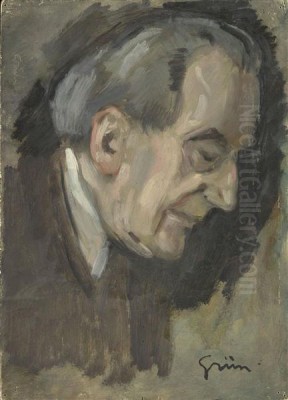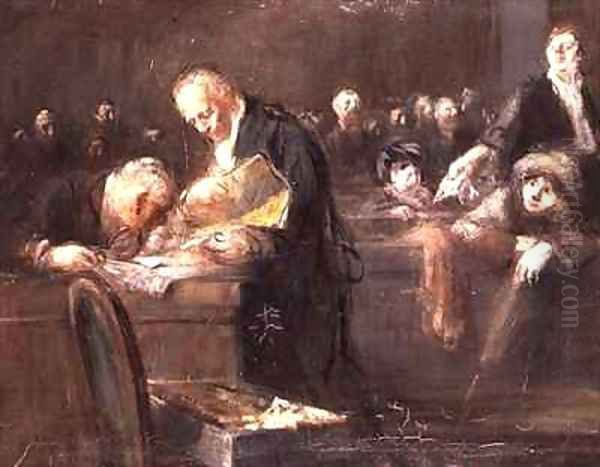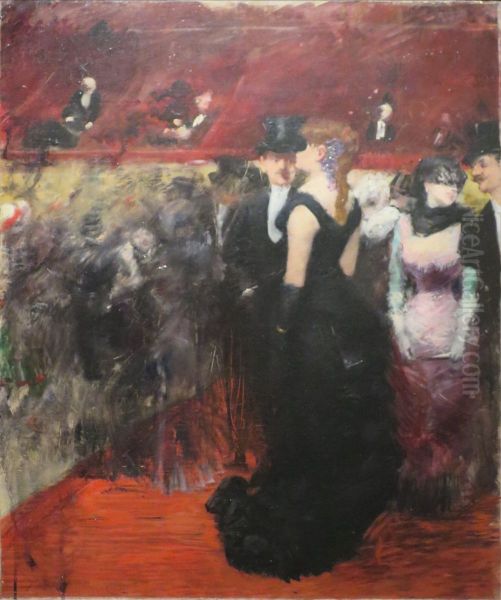
Jean-Louis Forain (1852-1931) stands as a significant yet sometimes overlooked figure in French art history. A contemporary of the Impressionists, he navigated the vibrant and tumultuous world of late 19th and early 20th century Paris, capturing its essence through painting, printmaking, and illustration. Known for his sharp wit and keen observational skills, Forain produced a body of work that offers a penetrating, often satirical, look at the society of his time, from the glittering stages of the opera to the somber realities of the courtroom and the trenches of World War I.
Early Life and Artistic Formation
Born in Reims, France, on October 23, 1852, Jean-Louis Forain came from modest beginnings. His father worked as an engraver of decorative symbols, providing a limited income for the family. Despite this, Forain displayed a passion for drawing from a young age. Recognizing his talent and ambition, his family supported his move to Paris at the age of fourteen to pursue formal artistic training, a significant step for a young man from the provinces.
In the bustling artistic hub of Paris, Forain sought out instruction from established figures. He briefly studied with the renowned sculptor Jean-Baptiste Carpeaux, known for his dynamic and expressive figures. Forain also dedicated time to self-education, diligently copying the works of Old Masters at the Louvre Museum, a traditional practice for aspiring artists seeking to understand composition, technique, and form. His formal academic training continued at the prestigious École des Beaux-Arts, where he enrolled in the studio of Jean-Léon Gérôme, a leading academic painter celebrated for his historical and Orientalist scenes.
Engagement with Impressionism
Forain's artistic development occurred during the rise of Impressionism, a movement that challenged academic conventions. While his training under Gérôme provided a foundation in traditional techniques, Forain was drawn to the innovative spirit of the Impressionists. He became closely associated with the group, particularly through his friendship with Edgar Degas. Degas, a pivotal figure in the movement, invited Forain to participate in the independent Impressionist exhibitions.

Forain contributed works to four of these groundbreaking shows between 1879 and 1886 (specifically the 4th, 5th, 6th, and 8th exhibitions). This participation placed him alongside leading figures like Claude Monet, Pierre-Auguste Renoir, Camille Pissarro, and Mary Cassatt. His involvement demonstrated his alignment with the group's desire to depict modern life and experiment with new ways of seeing and representing the world.
Forain absorbed key aspects of the Impressionist aesthetic, particularly their interest in capturing fleeting moments, the effects of light and color, and scenes of contemporary urban life. His subjects often mirrored those favored by his Impressionist colleagues: the racetracks, bustling cafés, theaters, and the opera. Early works, including watercolors and pastels, show a clear engagement with Impressionist techniques, utilizing a brighter palette and exploring the interplay of light and shadow in everyday settings. However, Forain never fully adopted the quintessential Impressionist style of broken brushwork; his work often retained a stronger emphasis on line and structure, hinting at his later focus on graphic arts.
The Influence of Degas and Manet
Among the Impressionists, Edgar Degas exerted the most profound influence on Forain. The two artists shared a deep and lasting friendship, often meeting at the Café de la Nouvelle Athènes in Montmartre, a famous gathering spot for artists and writers. They shared thematic interests, notably the world of ballet dancers, backstage scenes, and the racetrack. Forain greatly admired Degas's compositional skills and his ability to capture movement and psychological nuance.
While Forain learned much from Degas, adopting similar subjects and sometimes echoing his compositional strategies, he developed his own distinct approach. Where Degas often maintained a certain cool detachment, Forain's depictions frequently carried a sharper, more satirical edge. He used the shared subject matter to comment more explicitly on social dynamics, class distinctions, and the often-unglamorous reality behind the spectacle. Despite these differences, their bond remained strong, and Forain was among the mourners at Degas's funeral in 1917.
Forain also moved in the circle of Édouard Manet, another key figure in the transition from Realism to Impressionism, whom he likely met through Degas. While perhaps less intimate than his relationship with Degas, Manet's influence can be discerned in Forain's depictions of modern Parisian life and his interest in representing female figures within contemporary social contexts. Some accounts suggest Forain may have even provided illustrations related to Manet's work, highlighting their professional interaction.
Master of Satire and Illustration

Beyond his paintings, Jean-Louis Forain achieved considerable fame as a printmaker and illustrator, particularly renowned for his biting social and political satire. In this domain, his sharp wit and incisive line found their most potent expression. He became one of the most prominent graphic artists of the French Third Republic, his work frequently appearing in popular illustrated journals such as Le Figaro, Le Courrier Français, Le Monde Illustré, and Le Rire.
His lithographs, etchings, and drawings offered a running commentary on Parisian society, politics, and mores. He targeted the vanities of the bourgeoisie, the hypocrisies of the legal system, and the complexities of political life with unflinching acuity. His skill in caricature and his ability to distill a situation to its essence earned him comparisons to the great 19th-century satirist Honoré Daumier. Forain's line was dynamic and expressive, capable of conveying character and social commentary with remarkable economy.
A significant collection of his satirical work is found in La Comédie Parisienne, a series of albums published during the 1890s. These volumes gathered his incisive observations on Parisian life and pungent critiques of the political scandals and social issues rocking the Third Republic, such as the Panama Canal scandal and the divisive Dreyfus Affair, showcasing his role as a keen social commentator through his graphic art.
Artistic Style and Representative Works
Jean-Louis Forain's artistic style is characterized by its versatility and its blend of influences. While associated with Impressionism, his work often leans towards Realism, particularly in its narrative and critical dimensions. His early paintings, especially watercolors and pastels, show the Impressionist concern for light and atmosphere, capturing the ambiance of Parisian entertainment venues. Works like Le Verre du Lit (The Bedside Glass) exemplify this period, reflecting the "Gay Paree" atmosphere and his interest in café culture, rendered with a certain Impressionistic fluidity.
However, his background in academic drawing and his burgeoning career in illustration fostered a strong emphasis on line and structure. This is particularly evident in his prints and drawings, where bold, energetic lines define form and convey expression, often with dramatic use of light and shadow (chiaroscuro). His compositions could be complex, effectively organizing multiple figures and suggesting narrative depth, as seen in works like Dancer Sitting at a Table, which highlights his graphic skill honed through press cartoons.

Forain was a master of depicting the human figure, capturing gesture and posture to reveal character and social status. His satirical works often employed exaggeration, but his more straightforward depictions, particularly of dancers or working-class figures, demonstrate sensitivity and observational accuracy. He was also noted for his handling of sensitive themes, including the female nude, often portraying these subjects within the context of the backstage world or bourgeois interiors, sometimes hinting at exploitation or social commentary.
Later in his career, Forain's thematic focus shifted, embracing religious subjects. Works like the etching The Supper at Emmaus reveal this turn towards more profound, spiritual themes. This later style often featured darker palettes and a more somber mood, reflecting a departure from the lighter subjects of his Impressionist phase, though still rendered with his characteristic graphic power.
Chronicler of Modern Life
Forain's oeuvre provides a rich tapestry of Parisian life during the Belle Époque and beyond. He was fascinated by the city's contrasts – the glamour and the grit, the public spectacles and the private dramas. His canvases and prints transport viewers to the opera house, with its elaborate performances and intriguing backstage life, the energetic atmosphere of the racetracks, and the intimate, often lonely, ambiance of cafés and bars.
He was particularly drawn to the world of the theater and ballet, much like Degas, but often focused more explicitly on the social dynamics at play. He depicted the interactions between wealthy male patrons (abonnés) and young dancers, hinting at the power imbalances and transactional nature of these relationships. His portrayal of backstage life stripped away the illusion, revealing the hard work, fatigue, and vulnerability of the performers.
Forain also turned his sharp eye to the halls of justice. His numerous drawings and paintings of courtroom scenes capture the theatricality and human drama of legal proceedings. He depicted lawyers, judges, defendants, and plaintiffs with an eye for telling detail, often conveying a sense of cynicism about the legal system itself. These works stand as powerful social documents, exploring themes of guilt, innocence, and societal judgment.
The War Years and Later Transformation
The outbreak of World War I profoundly impacted Forain, as it did for many artists of his generation. Already in his sixties, he dedicated his artistic talents to the war effort, producing a large number of drawings and illustrations depicting life at the front and the realities faced by soldiers. These works, often published in newspapers, were imbued with patriotic sentiment but also conveyed the grimness and suffering of the conflict with stark realism. His war illustrations were praised for their emotional depth and insight, serving as both propaganda and poignant testimony.
The war years seem to have contributed to a shift in Forain's artistic and personal outlook. In the post-war period, his work increasingly explored more serious and often religious themes. This turn was partly influenced by his own deepening Catholic faith and perhaps a reaction to the perceived moral complexities and superficialities of modern society he had long satirized. His depictions of biblical scenes, like The Supper at Emmaus, or his continued focus on courtroom dramas, took on a more somber, introspective quality.
Stylistically, his later work sometimes moved away from the sharp linearity of his satirical prints towards a broader, more painterly handling, though his command of drawing remained central. Some critics saw this later phase as a quest for greater profundity, while others felt it lacked the incisive energy of his earlier satirical output. This period also saw him drawing inspiration from earlier masters, including perhaps the dramatic lighting and emotional intensity found in the works of Eugène Delacroix.
Controversies and Critical Reception
Throughout his career, Jean-Louis Forain's work often provoked debate and diverse critical responses. His satirical art, while popular with many, was sometimes criticized for its perceived vulgarity or for being too biting in its critique of established figures and institutions. The directness of his social commentary could be uncomfortable for those accustomed to more idealized representations of life.
His later shift towards religious themes also sparked discussion. Some viewed it as a genuine deepening of his artistic concerns, while others interpreted it as a decline from his earlier, more original contributions as a satirist of modern life. His complex relationship with Impressionism also led to critical ambiguity; he was part of the group, yet his style, with its emphasis on line and social commentary, set him apart from painters like Monet or Renoir, whose primary focus was on capturing visual sensations.
His wartime illustrations, though largely patriotic, were occasionally seen by some as overly harsh or even detached in their depiction of suffering. Furthermore, despite being highly regarded by fellow artists and critics like Guillaume Apollinaire and Édouard Vuillard during his lifetime, Forain's reputation experienced a period of relative decline after his death in 1931. His later works were sometimes dismissed as less innovative, and his significant contributions, particularly in printmaking and illustration, were temporarily overshadowed by the towering figures of Impressionism and Post-Impressionism.
Legacy and Rediscovery
Despite the fluctuations in his critical fortune, Jean-Louis Forain remains an important figure in French art. He was a multifaceted artist who excelled in multiple media, leaving behind a vast body of work that documents and critiques his era with unparalleled sharpness. His paintings capture the visual excitement of Parisian modernity, while his prints and illustrations offer enduring social and political commentary.
In recent decades, there has been a renewed appreciation for Forain's work. Exhibitions and scholarly research have shed new light on his career, recognizing his unique position as an artist who bridged the worlds of Impressionism, Realism, and graphic satire. He is increasingly acknowledged not just as a follower of Degas but as an original talent with his own distinct voice and vision. His influence can be seen in later generations of satirical artists and social realists.
Information regarding his private life remains relatively scarce compared to some of his contemporaries. While he was known to be friends with writers like Arthur Rimbaud and Paul Verlaine, sharing in the café society discussions of art and literature, detailed accounts from personal diaries or extensive published correspondence are not widely available. Evidence suggests that some personal letters exist, primarily held in private collections or archives, but they have not formed a major part of the public understanding of the artist.
Forain and the Art Institutions
Forain's relationship with the official art institutions of his time was complex. Like many artists associated with Impressionism, he participated in their independent exhibitions as an alternative to the rigidly juried, academically dominated Paris Salon. His inclusion in the Impressionist shows from 1879 onwards marked his alignment with the avant-garde. However, it's likely that Forain, like some other artists who moved between circles, also submitted works to the official Salon at various points in his career, particularly before his full immersion in the Impressionist group or perhaps later on. His primary renown within the exhibition context, however, stems from his participation in the Impressionist shows, which cemented his place within the narrative of modern art's development.
Conclusion
Jean-Louis Forain was more than just an Impressionist painter or a satirical cartoonist; he was a keen-eyed witness to the complexities of Parisian society during a period of profound social and cultural transformation. His work offers a unique blend of aesthetic sensibility, social observation, and sharp commentary. From the dazzling lights of the Belle Époque stage to the somber realities of the courtroom and the battlefield, Forain captured the human condition with honesty, humor, and pathos. As a painter, printmaker, and illustrator, he left an indelible mark on French art, and his incisive depictions of modern life continue to resonate with viewers today, securing his place as a vital chronicler of his time.